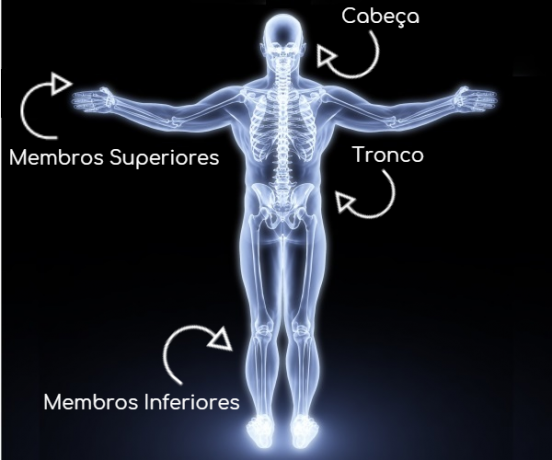The human body has many parts. In a basic way, it is divided into head, trunk and limbs.
The head is the upper part, and the limbs (upper and lower) are connected to the head through the trunk.

Head
The head has two parts: the skull and the face. The skull is where the brain is located, and the face is where the eyes, nose, mouth and ears are.
Brain
The brain is one of Organs most important organs in the human body, the most important in the nervous system. It is a brain mass that is covered and protected by the skull, formed by bones.
It is the body responsible for the control of brain functions and by the functions of information storage and processing about reasoning, sensations, memory, emotions, stimuli and intelligence. The brain controls almost all the functions that are essential for the survival and proper functioning of the human body.
parts of the brain
The brain is made up of two hemispheres (right and left), by the cerebellum and by brainstem. The brain also has a gray part called the cerebral cortex, where the neurons are located.
The cortex is divided into four parts with different functions (frontal lobe, parietal lobe, occipital lobe and temporal lobe).
- Frontal lobe: is responsible for body movements and important functions such as the ability to learn, think, speak and memorize.
- Parietal lobe: is responsible for sensory perceptions of temperature and pain, in addition to the perception of spaces.
- Occipital lobe: is responsible for the perception and processing of visual information (images).
- Temporal lobe: is responsible for auditory perception (sounds).
You hemispheres they are responsible for the ability to reason, the development of intelligence, the control of motor functions and the perception of sensory information.
One of the hemispheres is responsible for logical reasoning and the articulation of language. In most people, it is the left hemisphere that drives these activities. The other cerebral hemisphere is responsible for emotions, sensations and creativity. These functions, for most people, are controlled by the right hemisphere.
O cerebellum it is related to the body's ability to balance. It is connected to the cerebral cortex through connections that are formed by nerve fibers.
O brain stem it has the function of making the connection between the brain and the spinal cord. Through this connection, information about the functioning of the body, muscle contractions and reflexes are sent.
See the meaning of neurons.
 Frontal lobe (red), parietal lobe (yellow), occipital lobe (blue), temporal lobe (green), cerebellum (striped blue) and brainstem (purple).
Frontal lobe (red), parietal lobe (yellow), occipital lobe (blue), temporal lobe (green), cerebellum (striped blue) and brainstem (purple).
eyes, nose, mouth and ears
The eyes, nose, mouth and ears are organs linked to the perception and reception of stimuli from the senses. They are linked, respectively, to vision, smell, taste and hearing. These sense organs send information about incoming stimuli to different parts of the brain that control them.
- Eyes: are the bodies responsible for vision. The eyelids are part of the eyes, responsible for controlling the opening and closing of the eyes, and the eyelashes, which protect against the entry of dirt.
- Nose: is responsible for two important functions: breathing and smell perception (smell).
- Mouth: is responsible for the expression of language (through speech) and for the beginning of the feeding process.
- Ears: are responsible for the perception of sounds (hearing).
Stem
The trunk is the central part of the human body, which forms the union between the head and the upper and lower limbs. It consists of the following parts:
- Neck: makes the union of the head with the trunk of the body and allows the head to move.
- never: it is the part that is behind the neck, it is responsible for the support and movement of the head.
- Chest: it is formed by bones and has the function of protecting the organs that are located in this part of the body.
- Abdomen: is responsible for protecting and moving the spine.
- Hip: has several functions, such as balancing the body and protecting the reproductive system.
- buttocks: are formed by muscles and serve to allow movement of the thighs.
 Trunk and the organs located in it.
Trunk and the organs located in it.
Many organs that are important for the vital functioning of the human body are located in the trunk area. This is the case of the heart and lungs, which are located in the chest region.
Other very important organs are also in the trunk, such as the stomach, intestines (large and small), liver and thyroid gland.
members
The members of the human body are divided into upper and lower. The main functions performed by members are activities such as movement, balance and support of the body.
 Hands and shoulders (top), hips (center), feet and knees (bottom).
Hands and shoulders (top), hips (center), feet and knees (bottom).
The upper members are:
- shoulders: make the connection between the arms and the torso,
- Arms: make the movement of stretching and shrinking,
- forearms: are located between the elbow and the wrist,
- pulses: allow the articulation and movement of the hands,
- Hands: are responsible for picking up and handling objects and food.
The lower limbs are:
- Hip: also called the pelvis, it connects the lower limbs and the trunk,
- Thighs: help maintain and support the balance of the body,
- Legs: are responsible for the locomotion and support of the body,
- knees: have the function of articulating the legs,
- Feet: have the function of support and movement.
Learn more about how the Nervous system and the meaning of Anatomy.
